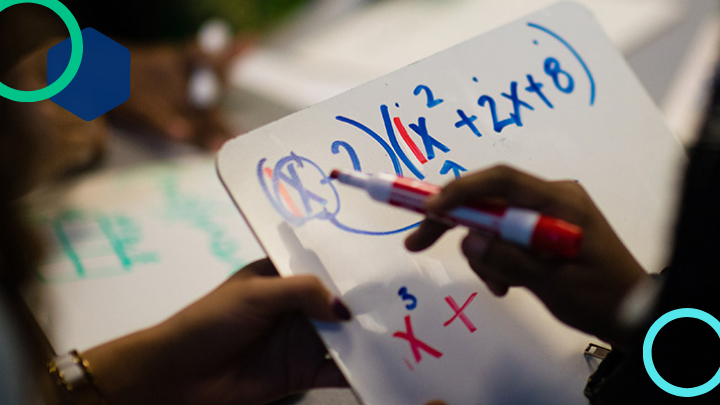As educators, many of us have felt the frustration of having taught a math unit only to discover that as weeks or months go by students have lost the knowledge they once seemed to have gained. As time passes and students move on to learning a new topic, it seems that students lose their math skills and ideas. It can almost seem as if they were never taught the material.
The strategies below support math retention by building connections between topics, visualizing math ideas, and focusing on students developing their math understanding in a way that makes sense to them. Choose what will work best for your group of students and your learning environment. You may find that combining a couple of the strategies below will work best for your students.
1. Help students to develop strong visualizations
Visualizing math means creating images such as pictures and diagrams to make sense of and communicate mathematical understandings. It can help students to create meaning and make connections between topics as well as connect to the real world. Using graphic organizers or manipulatives can help to support building these visualizations. Try out this visualization strategy that can be applied to any mathematical concept that you are teaching. To learn more about visuals in mathematics and how to apply it to your math content, see YouCubed.org,
2. Create student reference guides
Student reference guides can be as simple as notebooks filled with student work that show math skills and concepts in a way that is meaningful to each particular student. Students create their own reference guides so that they are creating tools that are meaningful to them. Helping students to create guided math notes and making it part of your math classroom routine will help students to have material to look back to when they need to reference prior learning. Note-taking can be combined with the visualization strategy, so that students have their own visuals that they have created, providing accountability and allowing students to take ownership of their learning. Students can also use additional reference tools like classroom anchor charts and digital notes and materials for retention.
3. Encourage mathematical discussions
Mathematical discourse is another critical feature of building retention. When students have the opportunity to discuss their ideas, revise their thinking, and build upon the ideas of others, they are able to make the necessary connections between ideas.
Number Talks
Number talks are an easy way to add more dialogue to your math classroom. They are short, structured conversations done in a 5-15 minute time period. Note: Be sure to establish class norms and expectations for these conversations. When expectations are set, it provides student accountability.
Stronger and Clearer Each Time
Another mathematical discussion routine is stronger and clearer each time. This routine involves several quick structured discussion opportunities that can help students to refine their ideas. The strategy includes a planning template that can help you to map out how to implement the protocol into your classroom.
2, 4, 6, 8 Collaborative Problem-Solving Structure
Another way to build dialogue into the math classroom is to provide collaborative opportunities. When students work together, they will engage in dialogue and learn from one another. Try the 2, 4, 6, 8 collaborative problem-solving structure to support students to engage in both independent and collaborative thinking.
4. Use mnemonic devices or acronyms
A mnemonic device is a memorization technique that can help to increase the ability to recall and retain information. Mnemonic devices can be used in any subject area and easily applied to math. A mnemonic device typically consists of a pattern of letters or ideas that can help to remember something such as the steps of how to solve a problem or how to perform a mathematical procedure. When students can apply the mnemonic device to math, they are creating a mathematical habit that will build their retention. Word problems can be particularly tricky for some students, but when provided with a mnemonic, they will be able to apply the strategy to solve any math problem. Mnemonic devices can be added to student reference materials, so students can refer back to the meaning of each letter and recall how to utilize the mnemonic.
CUBES method for problem solving
C – Circle the important numbers
U – Underline the question
B – Box the words that are keywords
E – Eliminate extra information
S – Solve the problem–be sure to show work
BUILD Problem Solving Approach
B – Box any directions
U – Underline the question
I – Identify important numbers by circling them
L – Location operation clue and put a star
D – Double-underline the units
Click here to learn more about using these acronyms in math.
5. Chunk Information
Chunking information means teaching content in “bite-sized pieces” that allows students to grasp one idea at a time before moving on. Chunking assignments can help students gain fluency, visually access information, overcome working memory differences, and even emotionally cope with the many demands of an assignment or project. When students are present and available for learning, they will retain more information. Chunking assignments to support student comprehension can make a big difference in helping them process, recall, and retain information.
6. Fill in the Gaps
Gaps are an inevitable part of education. Educators can develop targeted systems to fill in the gaps by having students analyze data and provide tasks that are targeted for each learner. The fill in the gaps strategy has templates to plan for implementation in your classroom. This strategy can be applied to any subject area for all learners.
Another strategy is the choice board, which gives students autonomy, choice, and accountability in their learning while allowing teachers to differentiate, observe and assess in real time.
Grouping students by their mathematical needs can help to build skills and support retention. Try out mild, medium, and spicy grouping to provide strategic grouping and appropriate learning activities that can support student mastery. A station rotation model can also provide opportunities for exercises to promote retention.
7. Develop a Mathematical Mindset
Many educators have heard about developing a growth mindset. When a student has a growth mindset, they believe that through hard work and determination they can achieve success. Embracing a growth mindset will help students persevere through challenges because when students believe they can get smarter, they put in extra time and effort that lead to higher achievement.
There are specific ways to apply the growth mindset to the mathematical classroom. For example, when students see the value of struggle and making mistakes, they will retain more math knowledge through having those experiences.
Teaching perseverance in math (sign up for a BetterLesson account to access this strategy) helps students understand how productive struggle helps them grow in their ability to solve math problems. Teaching perseverance in a math classroom can be difficult. Students do not like to fail. They do not like to grapple with difficult problems or tasks that they have the potential to fail. The productive struggle aids in retention by allowing students to develop a deeper level of understanding. To learn more about the mathematical mindset, see Youcubed.org.
The tools above are not only applicable to math classrooms–they can be applied to many subject areas to help students become successful independent learners. Learn more about how you can develop a student-centered classroom that equips students with skills and strategies to develop ownership and accountability of their learning with BetterLesson.








